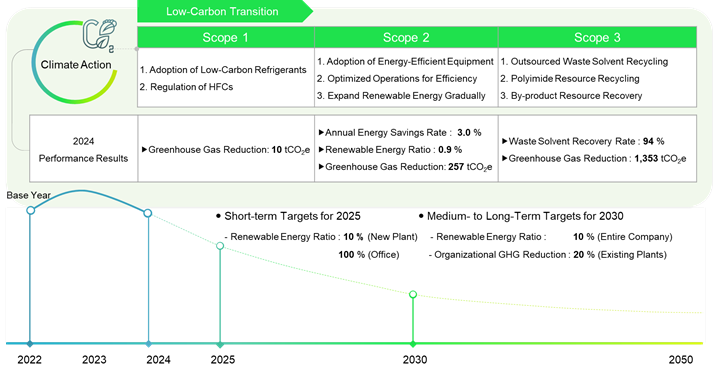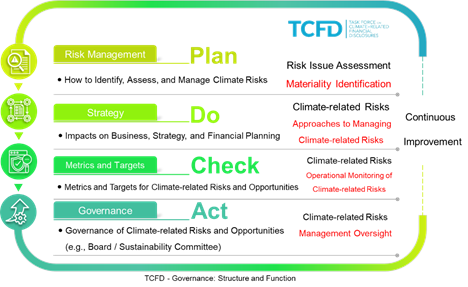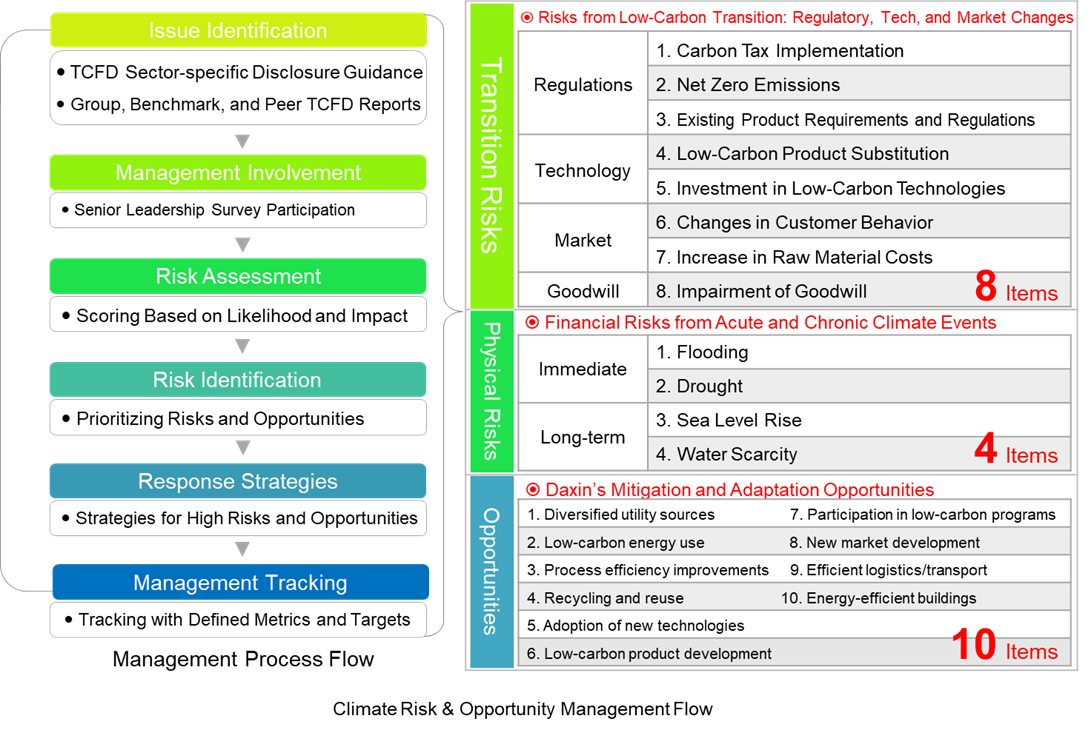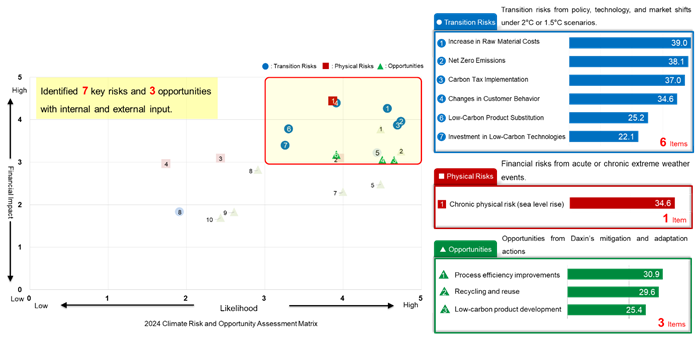ESG
Climate Action
Low-Carbon Transition Pathway
The first phase, "Energy Saving - Carbon Reduction," prioritizes greenhouse gas inventory, establishes baseline data, gradually builds a carbon management mechanism, and enhances energy efficiency through concrete and feasible energy-saving measures. At the same time, in 2024, green electricity will be introduced, marking the first step toward clean energy and carbon reduction.
The second phase, "Energy Creation - Low Carbon," combines the company‘s actual operational needs to explore appropriately scaled energy-saving technologies, including intelligent management and production process optimization. The company also actively seeks cost-controllable renewable energy solutions or purchases green electricity certificates to expand the application of renewable energy, reduce the operational carbon footprint, and ensure that Daxin maintains its competitiveness in the low-carbon transformation.
In the long-term third phase, "Integration - Zero Carbon," we will further advance circular transformation, integrate energy and resource recycling, enhance the efficiency of energy and resource utilization, and timely evaluate the introduction of zero-carbon technologies or the purchase of carbon credits for offsetting, in response to the global declaration and actions toward "Net Zero Emissions by 2050."

Climate Action Commitment
Daxin builds its climate strategy on a foundation of steady operations, setting prudent and pragmatic short-term (2025) and medium-to-long-term (2030) commitments. Carbon reduction is driven through systematic management and innovative technologies, including the annual implementation of energy-saving measures, investment in solar power generation, procurement of green electricity, and adoption of low-carbon refrigerants to progressively lower operational emissions and meet staged climate targets.
| Strategy and Action Plan | 2030 Mid- to Long-Term Goals | 2025 Short-term Goals | 2024 Execution Results |
| Enhance Energy Efficiency Implement annual energy-saving measures through the management plan, adopting energy-efficient equipment and optimizing operations to improve energy performance. |
Cumulative Energy Saving Rate from 2022 to 2030 ≥12.5% | Annual energy Saving Rate ≥1.5% |
|
| Building Low-Carbon Factories Conduct annual greenhouse gas verification to identify plant emission hotspots and implement transformation actions such as adopting low-carbon refrigerants. |
|
|
|
※ Note2 : RE (Renewable Energy) indicates the proportion of renewable energy.
※ Note3 : Annual energy saving rate = electricity saved / (total electricity consumption + electricity saved)*100%.
※ Note4 : New Plant refer to those officially put into operation after2023, including the Advanced Manufacturing CenterⅡ - Daxin Semiconductor Materials Plant.
※ Note5 : Existing plants refer to all company operation sites excluding New Plant.
Daxin is fully aware of the impact and importance of climate change on sustainable operations. Therefore, the Sustainable Development Committee coordinates and promotes various action plans to comprehensively implement sustainable development. The Sustainable Development Committee evaluates environmental, social, and corporate governance issues related to operations, and refers to climate-related financial disclosures (Task Force on Climate-related Financial Disclosures, TCFD) to conduct "climate change risk and opportunity assessments." Based on these assessments, response plans are formulated and management targets are set. The progress of sustainability projects is reported to the Board of Directors annually. The Board supervises the implementation of these plans according to the reports and provides timely guidance and suggestions to strengthen the effectiveness of sustainability strategy execution.
| Level | Supervisory Organization | Management Organization | Working Group |
| Organization | Board of Directors | Sustainable Development Committee | Environmental Sustainability Team |
| Authority and Responsibility | Supervise the operation of sustainability programs and provide timely recommendations. |
|
|
TCFD - Governance: Structure and Operations

Identification Management Process

The company refers to international sustainability trends and benchmark enterprises‘ TCFD reports to assess the likelihood and financial impact of various climate-related risks and opportunities. Through joint discussions between responsible departments and external experts, in 2024, Daxin identified a total of 7 major risks (including 6 transition risks and 1 physical risk) and 3 opportunities that require attention, and has developed corresponding response strategies.

| Risk Type | Risk Category | Major Risk Issues | Impact on Schedule | Potential Financial Impact | Key Response Measures |
| Transition Risk | Regulations | Government-imposed carbon fee | Medium to long term | Carbon emission costs under Taiwan‘s carbon pricing. |
|
| Regulations | Net Zero Emissions | Medium to long term |
|
||
| Technology | Low-carbon technology investment | Short, medium, and long term |
|
Promote and implement energy-saving measures (replacement of energy-consuming equipment, equipment improvement, and management enhancement). | |
| Technology | Low-carbon product substitution | Short, medium, and long term | R&D costs for low-carbon sustainable products. | Invest in R&D resources to develop low-carbon products that enhance customer product efficiency and reduce carbon content | |
| R&D costs for using low-carbon materials. | Invest in R&D resources to develop low-carbon products that use low-carbon materials or can reduce energy consumption during the manufacturing process | ||||
| Market | Changes in customer behavior | Long-term | Higher operating costs from climate initiatives and carbon footprint verification |
|
|
| Market | Increase in raw material costs | Medium to long term | Imported carbon taxes and higher electricity prices drive up raw material costs | Introduce raw material carbon footprint management and assess the feasibility of switching to procurement of low-carbon materials. | |
| Physical Risk | Long-term | Sea level rise | Long-term | Flooding causes production or supply chain interruptions. |
|
| Opportunity | Market | Develop low-carbon products | Short, medium, and long term | Satisfy customer needs and increase revenue. | Develop low-carbon products that can reduce the carbon content of customers‘ products and enter the low-carbon supply chain market. |
| Resource Efficiency | Using high-efficiency processes | Short, medium, and long term | Reduce electricity consumption and lower operating costs. | Implement energy-saving measures to mitigate rising electricity costs and future carbon fees. | |
| Resource Efficiency | Recycling and reuse | Short, medium, and long term | Resource recycling, reducing operating costs. | Promote the recycling and reuse of waste solvents to reduce the consumption of new raw materials and the cost of outsourced incineration treatment. | |
| Process by-product recycling to increase revenue. | Promote the resource utilization of polyimide and process by-products, and resell to customers to create economic benefits. |
For more information, please refer to Daxin Materials‘ 2024 Sustainability Report: Section 4.1 Climate Action.


